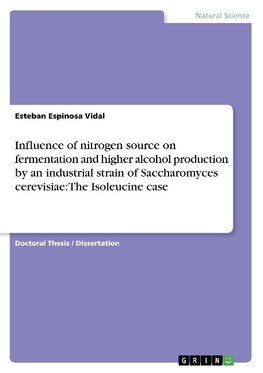
-
 Anglický jazyk
Anglický jazyk
Influence of nitrogen source on fermentation and higher alcohol production by an industrial strain of Saccharomyces cerevisiae: The Isoleucine case
Autor: Esteban Espinosa Vidal
Doctoral Thesis / Dissertation from the year 2012 in the subject Biology - Genetics / Gene Technology, Federal Rural University of Pernambuco (Institut National des Sciences Appliquées), course: Genetics, language: English, abstract: During the fermentation... Viac o knihe
Na objednávku, dodanie 2-4 týždne
44.37 €
bežná cena: 49.30 €
O knihe
Doctoral Thesis / Dissertation from the year 2012 in the subject Biology - Genetics / Gene Technology, Federal Rural University of Pernambuco (Institut National des Sciences Appliquées), course: Genetics, language: English, abstract: During the fermentation process, the yeast Saccharomyces cerevisiae produces a series of organoleptic compounds of interest in the alcoholic beverages background, among which outstanding the higher alcohols. Its formation depends on many factors, being the source and nitrogen concentration one of the most important. Recently, in industrial and artisanal cachaça stills, it has been common the addition of ammonium salts to improve the fermentation performance, however there are scarce information about this practice in the organoleptic background.
Considering this, we analyzed the fermentative profile, the transcriptomic levels and higher alcohols production with the aim of determine the nitrogen effect in the formation of higher alcohols, and consequently in the flavour profile. To achieve this, it was employed an industrial strain of S. cerevisiae JP1, used in the production of bioethanol and cachaça, in mineral medium cultures with different nitrogen sources in the form of ammonium (as sulfate salt), leucine, isoleucine, valine, tryptophan and phenylalanine. The production of higher alcohols reached levels between 300 to 1000 mg/L in the amino acid cultures, while in medium with ammonium supplementation the production was limited (8 mg/L).
In addition, was also observed a significant accumulation of higher alcohols other than the expected for a specific amino acid. Consequently, was corroborated the catabolism of branched and aromatic amino acids mainly follows the Ehrlich pathway, with the novelty that not expected higher alcohols could be produced in elevate amino acid concentration condition, caused probably a leakage of valine and leucine due to the overflow of amino acid cata
- Vydavateľstvo: GRIN Verlag
- Rok vydania: 2016
- Formát: Paperback
- Rozmer: 210 x 148 mm
- Jazyk: Anglický jazyk
- ISBN: 9783668270657












